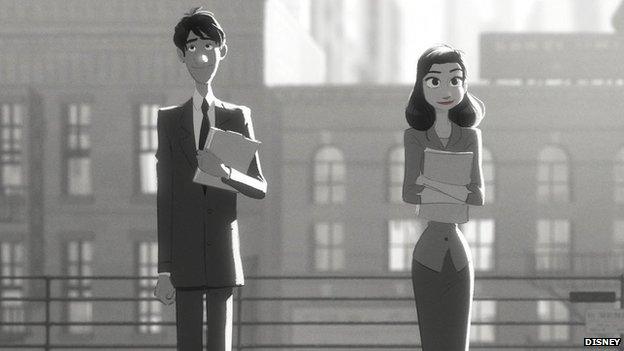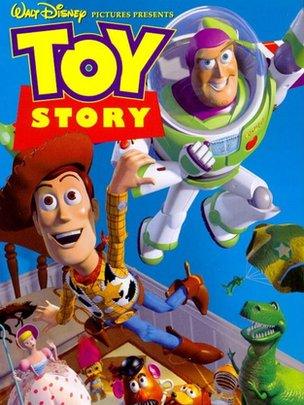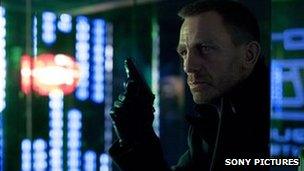Has drawing been erased from animation?
- Published

Oscar-winning short animation Paperman showed how traditional and new forms of animation could mix
Disney is not releasing a hand-drawn feature film in the next two years, its chief executive recently revealed, but it could be that news of animation's death has been greatly exaggerated.
"To my knowledge we're not developing a 2D or hand-drawn feature animated film right now," Bob Iger said earlier this month.
This shows a mainstream trend away from drawing by hand, even digitally, and towards modelling characters using a computer, first seen in a feature-length film when Toy Story was released in 1995.
Winning entry for the "What if" competition of the BBC made by Marina Koleva.
Technology is moving fast and it is opening up technical possibilities that were merely aspirations a decade ago.
But does this really mean the end of something that started with Snow White in 1937?
Disney has earned plaudits for its recent Oscar-winning short animation Paperman, external, with reviewers showering it with superlatives.
It mixes hand-drawn imagery with computer effects in a way that had not been used before.
"It's not a film that's entirely hand-animated but it's a film that couldn't exist without hand animators practising their craft," says Brendon Connelly, lead writer on film at Bleeding Cool, external.
"It's made in a way that no other film has been made before."
This means integrating hand-drawn and computer-generated (CG) images, something that those used to purely generating images using computers were not quite used to.
"We were both blown away by the ability that line artists have to put expression just in a single line," Paperman producer Kristina Reed told Wired, external.
"Just how by lifting a lip up a little bit or turning an eye, there's so much expression that can be conveyed. And when you're trying to do that in the CG world, it's really, really hard and you get very separated from the actual art."
A host of animators and illustrators hope Paperman's success means the death of drawing animation by hand has been greatly exaggerated.
Their skills are seen as irreplaceable by some critics.
"If you give an animator a piece of paper and ask them to draw a frame, the way they go about it is completely different to them sat in front of a computer modelling it and tweaking it by moving variables," says Connelly.
"Every animator I've ever spoken to who can draw with a pencil talks about intuition and fluidity when working in hand-drawn that they're faking when they're working in CG."
But those who work in digital animation do not accept they are "faking it".
While the methods have changed over the years, using pixels rather than pencils still requires drawing and animation skills.
"The bottom line is, even if you're making something entirely digitally, there is a craft of animation regarding traditional drawing skills and ways of making things move," says Gary Thomas, associate director of the charity Animate Projects.
"Those are skills required whether you're making a flip book or doing something entirely with CGI."
'What pencil did you use?'
Ever since Toy Story there have been those who question if the method of production really matters.

There are concerns that the days of pencils and brushes in any animation films are numbered
Disney has been steadfast in its belief that creativity is king and tools are just tools.
"They're unbelievable tools but they're really no different than a pencil and a piece of paper," John Lasseter, chief creative officer of Walt Disney and Pixar animation, said in a lecture last year., external
"No-one goes to [traditional animation legends and says] 'wow, what pencil did you use? I've got to get me a box of those'. We have amazing tools but they do not create anything. It's really what the filmmakers do with it."
This is not the first time death notices have been posted for hand-drawn animation.
Disney was meant to be closing all its 2D studios before its most recent hand-drawn feature, The Princess and the Frog, in 2009, was even announced.
But if the really big films move away from entirely hand-drawn techniques, does that mean an end to pencils and paper?

Toy Story, the first 3D computer animation feature, heralded a second "golden age" of animation.
"Just because Disney stops doing that doesn't mean everyone who does hand-drawn animation stops but it might change commercially," says Thomas.
He says: "For any animation, you need to be able to draw in the first place. If you can't draw with a pencil in your hand, you're not going to be able to draw in a computer. It's still drawing.
"A human being still has to tell a computer how to make a character move and that's still animation skill. You could say that's still drawing."
Instead of drawing each frame, modellers have to make the character move accurately and it is a complex experience.
Each joint a character would move is manipulated and moved by an animator.
"Each of those characters has got over 1,000 points of articulation," says Connelly.
"It's a very skilled job and [requires] understanding the way different parts of the body move.
"The computer doesn't really do the creative work or fill in the blanks meaningfully but it's still more like puppeteering in very slow motion rather than drawing," he says.
'Animation is everywhere'
So where is the animation industry heading?
"Animation is simultaneously pushing in different directions," says Chris O'Reilly, co-founder of animation company Nexus.
O'Reilly, whose company was Oscar-nominated for the animated short This Way Up in 2009, says: "Digital innovation is making animation more lifelike and photo-realistic. Yet at the same time, there is a resurgence of 2D animation and stop motion as almost a backlash against digital towards warm, crafted animation.
"What's really interesting is the blended area between that - where you can use some of the innovations [alongside] the crafted values in ways you wouldn't have been able to do before," he says.
This could herald a third wave of animation. The first came with Snow White in 1937, the second came with Toy Story and, O'Reilly believes, a third is just around the corner.
"Toy Story was often talked about as the second golden age of animation: suddenly all these massive studio 3D movies were possible," he says.

Even films like Skyfall have used animators in their production to add content to scenes
"That feels like that has come to an end and we're looking at the next wave of innovative independent animated features. We're on the cusp of that being possible and we will see a different nuance of animated features."
If this is to be the case, then it appears that animation is growing in scope, in size and in expectation. And this appears to be infiltrating even the most traditional output of Hollywood.
"Animation is everywhere now," says Thomas. "It's called CGI or VFX but those are skilled animators making Skyfall and almost every feature film. It's animators doing it.
"It's not that animators are now working on filmed films; filmed films are now more like animation."
The question is whether animation in the future will still require a pencil at all.